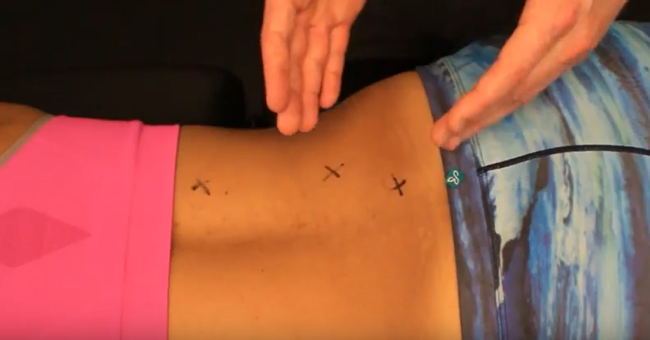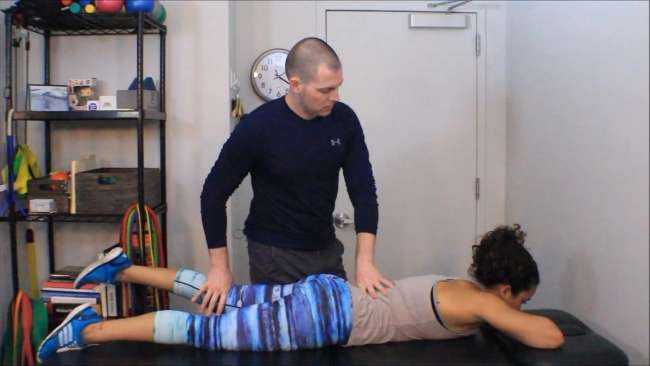Research Review: The Effects of Low Back Pain and Rehabilitation on Back and Hip Extensor Activities During Trunk Flexion/Extension
By Sofia Costa DPT, PT, CES
Edited by Brent Brookbush DPT, PT, COMT, MS, PES, CES, CSCS, ACSM H/FS
Original Citation: Leinonen, V., Kankaanpää, M., Airaksinen, O., & Hänninen, O. (2000). Back and hip extensor activities during trunk flexion/extension: effects of low back pain and rehabilitation. Archives of physical medicine and rehabilitation, 81(1), 32-37. ABSTRACT
Why the Study is Relevant: Altered lumbo-pelvic rhythm and muscle activation patterns have been observed in individuals with chronic low back pain (CLBP), specifically during trunk flexion and extension (1-3). This 2000 study by Finnish researchers added to the body or research, comparing activity of the lumbar papraspinals , gluteus maximus and biceps femoris muscles during standing flexion (toe touch) and extension (back to upright) in CLBP patients to pain-free controls. A follow-up assessment with the CLBP patients was performed while actively participating in a physical rehabilitation program. The study noted a relative reduction in gluteus maximus activity in CLBP patients implying that human movement professionals should consider adding gluteus maximus activation to programs designed for CLBP patients/clients.

Erector spinae and multifidus trigger points.
Study Summary
| Study Design | Cross-sectional with prospective follow-up |
| Level of Evidence | IIA evidence from at least one controlled study without randomization |
| Subject Characteristics | Sample: Demographics
Inclusion Criteria:
Exclusion Criteria:
|
| Methodology |
|
| Data Collection and Analysis |
|
| Results | Initial Trunk Flexion: Controls: Lumbar paraspinal and biceps femoris muscles were active simultaneously, followed by gluteus maximus activation.
End of Trunk Flexion:
Initial Trunk Extension:
End of Trunk Extension:
Post Active Physical Rehabilitation Program for CLBP:
|
| Our Conclusions | The findings of this study suggest that a reduction in total activation time of the gluteus maximus (hypo-activity) may be correlated with CLBP and that rehabilitation may effective for reversing this trend. This is congruent with the proposed changes to muscle activity and recommended interventions in the Brookbush Institute's predictive model of Lumbo Pelvic Hip Complex Dysfunction (LPHCD). |
| Researchers' Conclusions | The recruitment patterns demonstrated by CLBP patients and controls were not significantly different; however, the activation time of gluteus maximus muscle was significantly shorter during trunk flexion and trunk extension in CLBP patients. This indicates the hypoactivity of the gluteus maximus in these patients. Exercises emphasizing on gluteus maximus muscle activation should be included in a low back rehabilitation program. |

Dr. Brookbush performing a Manual Muscle Test for Gluteus Maximus on a patient.
Review & Commentary: Previous studies have investigated lumbar paraspinal muscle activity during trunk flexion-extension; however, fewer studies have investigated these muscles in conjunction with hip extensor musculature (gluteus maximus and biceps femoris ) (1-3). This study investigated the lumbar paraspinal , gluteus maximus and biceps femoris during trunk flexion-extension cycles and observed the differences between participants with chronic low back pain (CLBP) compared to pain-free controls. In healthy controls, gluteus maximus relaxation followed biceps femoris relaxation during extension to upright standing, in pain patients gluteus maximus activation time was shorter during flexion and the gluteus maximus relaxed prior to biceps femoris during extension to upright standing.
The study had many methodological strengths, including:
- The assessments and outcome measures were previously validated, enhancing the strength of the study.
- Collecting EMG data on lumbar paraspinal , gluteus maximus and biceps femoris activity simultaneously, allowed the activity of these muscles to be compared to one another and recruitment patterns to be identified.
- The inclusion and exclusion criteria narrowed the participant pool to a specific, but common patient population (CBLP), reducing the likelihood that structural change or alternate diagnoses influenced findings.
- The addition of a rehabilitation program and follow-up added clinical significance by implying that the finding were modifiable with specific intervention.
Weaknesses that should be noted prior to clinical integration of the findings include:
- Although the impairments addressed were listed, the interventions and exercises used were not specified,reducing reproducibility of study findings.
- All participants were female which may impart a gender bias on findings.
- All but one participant took part in a previous study investigating back and hip extensor fatigability (4), and thus may have had prior knowledge of testing parameters and expected outcomes.
- The pattern used may not have been representative of a functional task, as participants were expected to lock their knees during the flexion/extension cycle.
Why This Study Is Important:
This study adds to a body of research demonstrating altered muscle activity and recruitment in those individuals exhibiting chronic low back pain (CBLP). Specifically, the findings of this study support the implication of several studies demonstrating a reduction in gluteus maximus activity relative to Lumbo Pelvic Hip Complex Dysfunction (LPHCD) . In this study total activation time was reduced, adding nuance to our understanding of "hypo-activity" which may also include a reduction in motor unit recruitment, latent or delayed activation, and/or a decrease in muscle strength.
How the Findings Apply to Practice:
The findings of this study suggest that chronic low back pain results in decreased activation time and altered recruitment pattern of the gluteus maximus , and that this activity may be corrected via gluteus maximus activation . Human movement professionals should consider assessment and strengthening of the gluteus maximus when addressing chronic low back pain.
How does it relate to Brookbush Institute Content?
The findings of this study suggest that a reduction in total activation time of the gluteus maximus (hypo-activity) may be correlated with CLBP and that rehabilitation may be effective for reversing this trend. This is congruent with the proposed changes to muscle activity and recommended interventions in the Brookbush Institute's predictive model of Lumbo Pelvic Hip Complex Dysfunction (LPHCD) , as well as the models of Lumbosacral Dysfunction (LSD) and Lower Extremity Dysfunction (LED) . As mentioned above, the findings of this study add a layer of nuance to our understanding of under-activity, as the reduction in activation time, differs from other studies demonstrating latent firing, a reduction in peak EMG activity and/or a reduction in gluteus maximus strength. The BI has professed the importance of both gluteus maximus assessment and gluteus maximus activation for various commonly noted pathologies including chronic low back pain, and has built a significant library of techniques for addressing the issue
Recommended Article: Gluteus Maximus Activation
The following videos illustrate a sample of common assessment techniques and interventions for the gluteus maximus :
Gluteus Maximus Manual Muscle Testing for an Active Population:
Gluteus Maximus Activation:
Gluteus Maximus Activation Progression:
Bibliography:
- Floyd, W. F., & Silver, P. H. S. (1955). The function of the erectores spinae muscles in certain movements and postures in man. The Journal of physiology, 129(1), 184-203.
- Sihvonen, T., Partanen, J., Hänninen, O., & Soimakallio, S. (1991). Electric behavior of low back muscles during lumbar pelvic rhythm in low back pain patients and healthy controls. Archives of physical medicine and rehabilitation, 72(13), 1080-1087.
- Paquet, N., Malouin, F., & Richards, C. L. (1994). Hip-spine movement interaction and muscle activation patterns during sagittal trunk movements in low back pain patients. Spine, 19(5), 596-603.
- Kankaanpää, M., Taimela, S., Laaksonen, D., Hänninen, O., & Airaksinen, O. (1998). Back and hip extensor fatigability in chronic low back pain patients and controls. Archives of physical medicine and rehabilitation, 79(4), 412-417.
© 2017 Brent Brookbush
Questions, comments, and criticisms are welcomed and encouraged.


